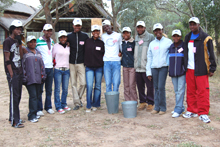ADVENVIRO 2006: What the SAEON kids had to say
|
DAY 1
LESSON 1
Topic: Global environmental
crisis
Presenter: Dr Dave Balfour
|
We spoke about all the types of global change, and one of them was global warming, which is caused by a high concentration of carbon dioxide in the atmosphere. We discussed the causes of this widespread problem and found that air pollution and rapid destruction of natural vegetation are the most serious factors.
LESSON 2
Topic: Introduction to Science
Presenter: Dr Dave Balfour
Dr Balfour defined 'science' as a study. He brought us to a realisation that science has a great influence on our lives. This lesson was so informative, we identified the different types of sciences and scientists that exist in the world today and observed how technology has advanced for research purposes.
LESSON 3
Topic: Conservation development in
South Africa
Presenter: Meiring Prinsloo
We were introduced to game ranching, its origin and the main purpose of Peace Parks in the country. We discussed the effect of Game Parks that are situated near communities. These parks provide jobs and create effective conservation awareness programmes. We now know about the IUCN (International Union of Conserving Nature) and TFCA (Trans Frontier Conservation Areas) and their functions.
DAY 2
LESSON 4
Topic: Monitoring
Presenter: Dr Dave Balfour
Why counting is necessary - to observe change around us. We found that this topic is related to 'Land Transformation' because we need to record the pace of change on land. In this way, we can make the necessary precautions for further change in the future.
ACTIVITY
Topic: How to count without
counting
Presenter: Dr Dave Balfour
The mark and recapture method, an easier and more convenient way of counting large amounts of a certain object. This method is used in game reserves when recording the number of a certain species. We practiced this method by making use of stones in a bucket.
LESSON 5
Topic: Ecology
Presenter: Dr Dave Balfour
We were taught of how the environment works to balance itself out, for example; an elephant pushes down a tree and makes it more accessible for bucks to eat. We learned about forests, grasslands and savannas. A savanna is a place where both grass and trees survive and fires are started and controlled here so that the savanna does not evolve into a forest.
FIELD ACTIVITY
GAME DRIVE
Presenter: Meiring Prinsloo
The most exciting thing was seeing the lioness and her cubs. We went to a waterhole in the park and discovered that it was formed when the road nearby was under construction. Although the park creates jobs, it is also dangerous because the fence is wrecked and animals can easily enter and exit the park.
DAY 3 ACTIVITIES
GAME DRIVE at HESC (the Hoedspruit Endangered Species Centre)
We learned about the breeding process of the cheetah and why the cheetahs are kept in separate sections. We saw wild dogs, vultures and a remarkable parrot!
Topic: The nature and range of
research done on the cheetah
Presenter: Prof David Meltzer
A cheetah was tranquilized for us to observe its adaptations at a closer distance. It felt great to touch the animal and examine it. The cheetah has a narrow body and it uses its tail for balance and for swaying from side to side.
ACTIVITY
Topic: Conservation and
Environmental Fieldwork
Presenter: Jacques Moller
We realized that the environment needs every organism for balance; if one is removed the whole cycle breaks down. We went 'spoor tracking' using our senses. We examined the freshness of prints and its direction and in this way we identified five animals without seeing them. We learned about the medicinal value of plants around us.
DAY 4
LESSON 6
Topic: Insects and Environment
Presenter: Hendrik Sithole
We learned about the different types of insects and classified them into two groups: Good and Bad insects. We now realize that insects are important and if they are removed from the environment, the cycle is destroyed.
LESSON 7
Topic: Insects and Environment
Presenter: Hendrik Sithole
Hendrik proved to us that insects are similar, they all have six legs and their bodies have three segments. The only difference is that some have wings and some do not.
IN GENERAL:
CONTENT
The presentations have widened our confidence span; we enjoyed spending time exploring what the wild has to offer. In just under a week we gained more than we could ever ask for. We now realize the importance of Peace Parks in our country and mostly to the environment. It is vital to know more so you can teach others. We as the learners are grateful for the opportunity we had in the week, we have experienced what others can only dream of doing.
ARRANGEMENT
The place was great, good hospitality and service was the way to go for the people at the South African Wildlife College (SAWC). We enjoyed it!
We want to be anchors of the group of 2007; we want to share with them what SAEON did for us.
This is for SAEON:
Thank-you for honouring us by making us the first SAEON kids, we will forever cherish and 'reserve' this chance we had as a group the past week.
Meeting the professors and scientists was a privilege and learning that much was an even greater honour. We have learned a lot and if it were up to us we would have camped out for a whole month!
The SAEON Kids












